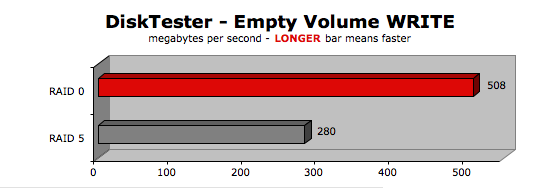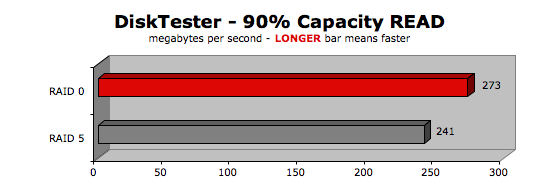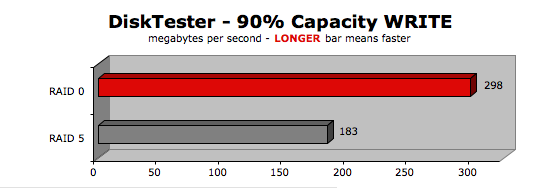
|
|
Posted November 1st, 2005, by rob-ART morgan, mad scientist The HighPoint RocketRAID 2224 SATA II PCI-X 66/100/133 host adapter is unique in that it features a single external 'Infiniband' connector/cable scheme that supports 4 external drives. It requires the use of Highpoint X4 four bay Infiniband enclosure. We tested the adapter and enclosure with a eight Hitachi 7K500 drives in both RAID 0 and RAID 5 mode. ANALYSIS The Highpoint X4 enclosure, designed to work with the external infiniband connector, comes with removable trays and requires you to lock the trays before the drives will spin up -- an interesting safety precaution. It's one of the few enclosures we've tested that doesn't use short cables to connect the drives to the backplane but rather has the drives connected directly. Though our graphs show the numbers for 8 drives, we tested the 4 external drives on the 'Infiniband' cable against the 4 internal drives on standard connectors. The speeds were identical, confirming that nothing is lost by using the special cable scheme. As you know by now, the RocketRAID 2224 (and its siblings, the 2220 and 1820A) offer support for RAID 0, 1, 5, 10 and JBOD in the firmware using a special RAID manager. Because you are configuring the RAID 0 and RAID 5 in firmware, they appear to Apple's Disk Utility as a single virtual drive. When we posted our review of the 2220, we ran against a 2 terabyte limit. But they have since put their heads together with Apple and overcame that limit. So if you present Apple's Disk Utility with eight 500GB drives in firmware RAID 0 or RAID 5 array, it will now see the full 3.6 terabyte virtual drive. HOW ABOUT A PCI EXPRESS VERSION? IS RAID 5 FAST ENOUGH FOR UNCOMPRESSED HD VIDEO? USING PARTIONING FOR OPTIMIZATION HOT SWAP? When a new drive has been added, you must go into the RAID Manager and click on the Rescan Button to add a new disk(s). It initiates a rescan and finds any new disk(s) added to the controller. OTHER FEATURES NO BOOT SUPPORT TEST HARDWARE The HighPoint RocketRAID 2224 SATA II PCI-X 66/100/133 host adapter with 4 internal ports and 1 Infiniband external port was installed in the 133Mhz slot 4 of the G5 Power Mac. We connected the Highpoint X4 four bay Infiniband enclosure to the external port. Instead of putting the second four drives inside the G5, we installed them in a WiebeTech eSATA TrayDock enclosure and ran the cables out an empty PCI-X slot. (Ideally, we would like to see a RocketRAID with two Infiniband connectors.) The drives used were eight Hitachi 7K500 500GB SATA II drives tweaked with Hitachi's DOS utility to run as true SATA II drives (up to 3GB/s). TEST SOFTWARE RELATED ARTICLES BareFeats reviews the HighPoint RocketRAID 2314 BareFeats reviews the HighPoint RocketRAID 2322 BareFeats reviews the HighPoint RocketRAID 2320 BareFeats reviews the HighPoint RocketRAID 2220 WHERE TO BUY HIGHPOINT ROCKETRAID SATA HOST ADAPTERS OTHER SOURCES FOR Serial ATA PRODUCTS FirmTek (host adapters, enclosures, and cables) Granite Digital (enclosures, host adapters, brackets, and cables) Kano Technologies (enclosures and host adapters) MacGurus (host adapters, enclosures, bare drives, coolers, hot-swap trays, cables, converters) MaxUpgrades (internal drive kits for G5) Other World Computing (enclosures, bare drives, and host adapters) Small Dog Electronics (enclosures and host adapters) TransIntl.com (enclosures, bare drives, and host adapters) Wiebetech.com (enclosures and host adapters) LaCie (enclosures and host adapters) FWDepot (enclosures, host adapters, cables) Sonnet Technology (host adapters, enclosures, and cables) Has Bare Feats helped you? How about helping Bare Feats?
and matching X4 enclosure


As you can see in the two graphs above, the READ speed of RAID 5 is not that much slower than RAID 0. But look at the WRITE speed. You lose almost half to gain the "safety" of RAID 5. When the volume is empty, it's actually fast enough with RAID 5 to capture uncompressed HD 1920x1080 10 bit RGB video. But as you fill up the RAID 5 volume, the WRITE speed drops well below the target 237MB/s. (See graphs below.)


The HighPoint RocketRAID 2224 SATA II PCI-X 66/100/133 host adapter takes a fascinating approach to the external port issue. While LaCie has opted for Port Multiplication (where up to 5 drives share a data channel), HighPoint has chosen the path of an Infiniband cable/connector scheme where 4 drives require only 1 cable but actually each have their own data channel. The connector locks down securely which is a welcome feature. I only wish there were two external 'Infiniband' connectors. That may happen at some point.
As of November 11th, HighPoint Technologies posted Mac drivers for their new RocketRAID 2320 PCI Express 4X SATA II RAID host adapter.
Not if you are trying to capture 1920x1080 10bit RGB HD uncompressed video on a volume that's almost full. However, if you have lesser requirements such as 1280x720 10bit HD, then you can maintain the required speeds with RAID 5, even when the volume is almost at capacity.
One nice thing about firmware based RAID is that you can partition it easily with Disk Utility (since it is presented as a single virtual drive). That way you can isolate the slower section of the volume. I suggest when setting up a new RAID set (whether RAID 0 or RAID 5) that you format it as one partition. Then use either ZoneBench or DiskTester to sample the various zones of the volume. When you find out at which zone the READ or WRITE speed drops below your target, you can isolate that zone and the subsequent slower zones by putting them in a separate partition.
The RocketRAID 2224 doesn't support Hot Swap in the traditional sense. Hot Swap is allowed only when using the RAID Manager. Users will need to login to the RAID Manager and click on the Maintenance button for the RAID Array. The second button (“Unplug”) allows users to unplug RAID arrays or single disk without having the controller report a broken RAID. This also helps when single disk has fallen offline due to power loss, loose cable, or disk failure.
The 2220 and 2224 drivers for Mac included S.M.A.R.T. disk monitoring of single disk and RAID sets. There is an option for Email notification of activities on the RAID array. There is also a Task Manager that allows users to schedule periodic events on the RAID array. If users want to schedule a RAID 5 array verify every month at certain hour, they can do so in RAID Manager.
The RocketRAID requires a driver to be loaded by OS X at startup in order to mount its drives. Therefore neither the individual drives nor a RAID set connected to it can be used as a boot volume. (At this time, only FirmTek SeriTek SATA host adapters support booting.)
Testing was done with an Apple G5/2.5GHz Power Mac (8GB memory, Raptor 73GB boot drive.)
DiskTester is unique drive testing utility that is run using Terminal. It gives you many options to chose. We ran the area test so we could sample various zones on the volume from "empty" to "full" (outer tracks to inner tracks). We specified a 1GB test file, 10% increments, 3 iterations, system cache disabled.
Use "BAREFEATS" coupon code to get 10% off the X-SPAND or 5% off everything else
"BARE facts on Macintosh speed FEATS"
Email , the webmaster and mad scientist